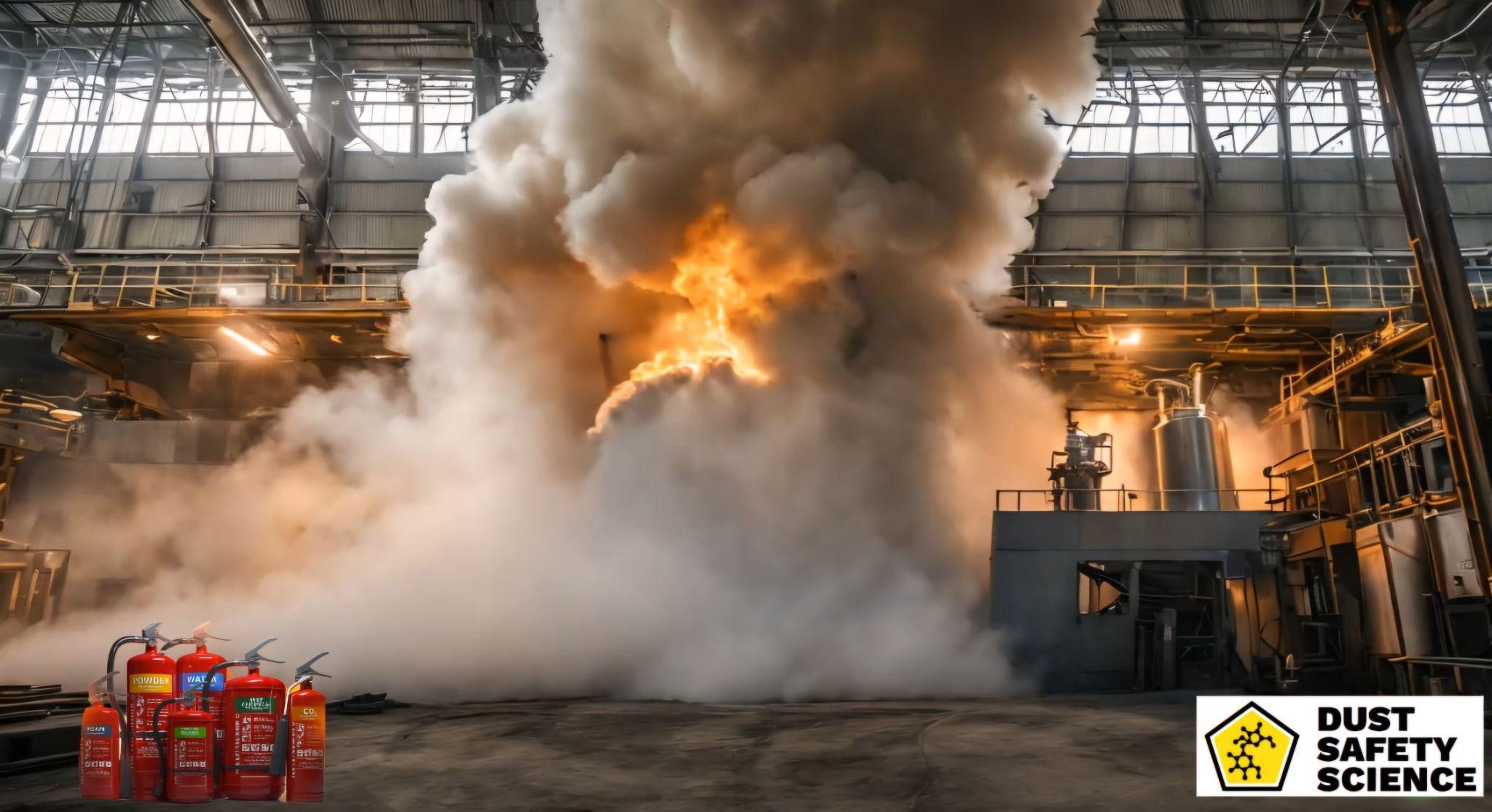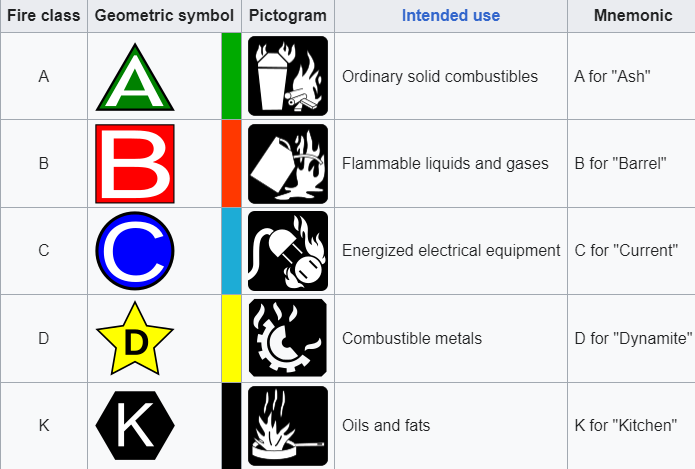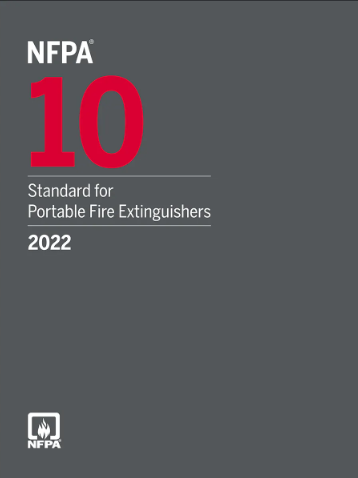Updated December 23, 2024 Authored by Dr. Chris Cloney and Jon Barrett of Dust Safety Science

What Are the 5 Fire Classes?
Fire classes are defined categories that help in understanding the nature of a fire and the suitable methods for extinguishing it. These classifications are based on the fuel sources involved and the specific risks they pose. By identifying the type of fire, responders can select the right extinguishing agents and techniques, preventing the spread of flames and reducing the potential for injury or property damage.
The main classes of fire include Class A, B, C, D, and K, each defined by its fuel source and hazards. Classifying fires ensures a systematic approach to fire response, making it possible to address each situation with the appropriate strategy. The National Fire Protection Association, NFPA, created the NFPA 10 Standard for Portable Fire Extinguishers. NFPA 10 provides requirements to ensure that portable fire extinguishers will work as intended to provide a first line of defense against fires of limited size.
According to Wikipedia, a fire class is a system of categorizing fire with regard to the type of material and fuel for combustion. Class letters are often assigned to the different types of fire, but these differ between territories; there are separate standards for the United States (NFPA 10 Chapter 5.2.1-5.2.5), Europe (DIN EN2 Classification of fires (European Standard) ISO3941 Classification of fires (International Standard), and Australia (AS/NZS 1850). The fire class is used to determine the types of extinguishing agents that can be used for that category.

Detailed Breakdown of the 5 Fire Classes
Class A Fires: Ordinary Combustibles
- Common sources: Class A fires are fueled by materials like wood, paper, cloth, rubber, and certain types of plastics. These are among the most common fires encountered in residential and commercial settings.
- Identification: Class A fires often produce bright flames and generate heat and smoke. They are characterized by the combustion of materials that leave ash or embers.
- Response strategies: Water is the most effective extinguishing agent for Class A fires, as it cools the burning material and reduces its temperature below the ignition point. Foam extinguishers can also be used, providing a cooling and smothering effect to prevent re-ignition.
Class B Fires: Flammable Liquids and Gases
- Common sources: Class B fires involve substances like gasoline, oil, grease, paint, and solvents. These fires are common in industrial settings and workshops where flammable liquids are used or stored.
- Identification: Class B fires spread quickly and can produce large flames with thick, dark smoke. They are highly volatile, and improper extinguishing techniques can cause splashing or the spread of burning liquid.
- Response strategies: Carbon dioxide (CO2) and dry chemical extinguishers are most effective for Class B fires. CO2 works by displacing oxygen around the fire, while dry chemicals like sodium bicarbonate break the chemical reaction of the fire. Water should never be used on Class B fires, as it can spread flammable liquids.
Class C Fires: Electrical Equipment
- Common sources: Class C fires involve energized electrical equipment, such as appliances, circuit breakers, wiring, and machinery. They pose a risk of electric shock in addition to fire damage.
- Identification: Class C fires often emit sparks, and bright flashes, or produce a burning smell from electrical components. They may also cause equipment failure or power outages.
- Response strategies: Non-conductive extinguishing agents like CO2 or dry chemical extinguishers are best for Class C fires, as they do not conduct electricity. The primary step is to de-energize the electrical equipment before using other methods to ensure safety.
Class D Fires: Combustible Metals
- Common sources: Metals like magnesium, titanium, sodium, and potassium can catch fire under certain conditions, creating Class D fires. These are most common in laboratories, metalworking industries, and aerospace applications.
- Identification: Class D fires often appear as bright, intensely hot flames. They can react violently with water or standard fire suppressants, making them highly dangerous.
- Response strategies: Specialized dry powder agents, such as graphite or sodium chloride, are used for Class D fires. These powders smother the fire by creating a barrier between the burning metal and oxygen. Water and CO2 should not be used, as they can cause explosive reactions.
Class K Fires: Cooking Oils and Fats
- Common sources: Class K fires are specific to commercial kitchens and involve cooking oils, greases, and fats. They often occur in deep fryers or stovetops.
- Identification: Class K fires tend to be intense and can quickly escalate if not addressed properly. They can be identified by their location and the presence of burning oil or grease.
- Response strategies: Wet chemical extinguishers are the preferred method for Class K fires. They work by forming a soap-like solution that cools and seals the surface of the oil, preventing re-ignition. Never use water on grease fires, as it can cause the oil to splatter and spread the fire.
Special Considerations for Combustible Dust Fires
Combustible dust refers to fine particles that, when dispersed in the air, can ignite and explode. Industries such as woodworking, food processing, and chemical manufacturing are especially prone to dust-related fires. These fires can cause significant damage, as the dust particles can burn rapidly when suspended in the air. Fine particles, such as combustible dust, can easily ignite and lead to dust explosions, which are often catastrophic. These combustible dust explosions occur when dust accumulates and becomes airborne, creating a dust cloud that can be ignited by heat sources, such as machinery, electrical sources, sparks, friction, or static electricity.
Dust clouds form when fine particulate matter becomes airborne, often due to industrial activities such as pouring, sifting, cutting, grinding, or transporting materials. These clouds can accumulate over time in hidden areas such as rafters, ductwork, or equipment, leading to dangerous buildup.
Managing combustible dust is identifying where it tends to accumulate. Dust can settle on surfaces such as floors, beams, ledges, and machinery, making it essential to inspect these areas regularly.
Key strategies to identify accumulation points include:
- Perform a Dust Hazard Analysis
- Regular visual inspections.
- Inspect confined spaces, overhead piping, beams, and suspended ceilings.
- Reviewing areas of low airflow, where dust may collect.
- Monitoring facility changes that could increase dust exposure (e.g., changes in production processes).
Combustible dust fires can be classified based on the type of material involved, often aligning with Class A or B fires, depending on whether the dust is organic or derived from flammable substances. The challenge lies in identifying and controlling dust accumulations to prevent explosions.
Prevention is critical in managing combustible dust hazards. Proper ventilation, regular cleaning, and dust collection systems can reduce the risk of ignition. For extinguishing, CO2 and dry chemical agents may be effective, but the key is to prevent dust clouds from forming.
Fire Response Strategies for Each of the 5 Fire Classes
A. Identifying the Type of Fire
In an emergency, accurately identifying the class of fire is crucial for deploying the correct extinguishing methods. Proper training and fire safety drills help ensure that employees can quickly recognize fire types and take the appropriate action.
B. Appropriate Extinguishing Methods
Each fire class requires a specific type of extinguisher or agent. Using the wrong method can worsen the situation, such as using water on an electrical fire or a grease fire. Understanding the compatibility between fire classes and extinguishing agents is key to effective fire management.
C. Fire Safety Protocols
Effective fire safety protocols include having a well-defined evacuation plan, conducting regular fire drills, and ensuring that all safety equipment is accessible and maintained. Training employees on these protocols ensures that response efforts are efficient and coordinated during a fire emergency.
Fire Extinguisher Types and Their Fire Class Applications
Different extinguishers are designed for specific fire classes:
- Water extinguishers: For Class A fires.
- CO2 extinguishers: Suitable for Class B and C fires.
- Dry powder extinguishers: Effective for Class B, C, and D fires.
- Wet chemical extinguishers: Designed for Class K fires.
Properly labeling and strategically placing these extinguishers is essential for quick access during an emergency.
Using the Right Extinguisher for the Right Fire
Selecting the appropriate extinguisher involves understanding the type of fire and knowing how to operate the extinguisher effectively. Common mistakes include using the wrong extinguisher or failing to fully discharge it, which can leave hot spots that reignite.

Technology Advances, with the Integration of Artificial Intelligence, (AI), Machine Learning, (ML), and Fire Classes
Recent advancements in Artificial Intelligence (AI), the Internet of Things (IoT), and Machine Learning (ML) are revolutionizing fire detection and prevention, enabling smarter and more efficient safety systems. AI-powered fire detection systems use advanced algorithms to identify and classify fire types in real-time, providing faster and more accurate responses. By analyzing data from multiple sensors connected via IoT, these systems can distinguish between different fire classes, such as Class A (ordinary combustibles) and Class B (flammable liquids), ensuring that the appropriate extinguishing method is deployed quickly. This integration of AI and IoT also allows for predictive analytics, where potential fire hazards are identified and mitigated before they escalate into an emergency.
Machine Learning further enhances fire prevention by continuously learning from past fire incidents and environmental conditions. ML algorithms can optimize fire suppression strategies by analyzing patterns and improving the efficiency of extinguishing methods. For example, ML can recommend the best extinguisher type—whether water, CO2, or dry powder—based on the specific class of fire detected. This technology-driven approach not only reduces human error but also increases the effectiveness of firefighting efforts, ensuring that the right tools are applied to the right situations. As AI, IoT, and ML continue to evolve, they are transforming fire safety, making environments more resilient and responsive to fire hazards.
Conclusion
Understanding the 5 types and classes of fire and the appropriate response strategies is essential for maintaining safety in any environment. Fire classes are categorized based on the type of materials involved, and each class requires a unique approach for safe extinguishing. Class A fires involve ordinary combustible materials such as wood, paper, and cloth. The right fire extinguisher for these fires involving these materials is usually water and foam extinguishers, which cool the burning materials and remove heat. Class B fires, or fires involving flammable liquids like gasoline or oil, require foam extinguishers or carbon dioxide units as they eliminate oxygen and reduce fire risks. Class C fires, commonly caused by electrical fires from electrical equipment like wiring and appliances, need carbon dioxide or dry powder extinguishers to prevent conduction risks. Class D fires, known as metal fires, often involve burning metals like magnesium, needing a dry powder extinguisher specific for combustible materials.
Class C and Class F fires require careful fire safety handling due to their complex fire risks. Class F includes kitchen fires involving cooking oils and fats in food service, where wet chemical extinguishers cool the cooking oil and form a barrier over its surface. Class C fires from fires involving electrical equipment need control over the power supply to ensure fire safety. For these electrical fires, carbon dioxide extinguishers or dry powder extinguishers are ideal, as they protect electronic equipment while isolating the flame. Understanding each fire risk helps ensure the right fire extinguisher is chosen, critical to handling fire safely.
In commercial or public buildings, understanding fire risks by fire class is vital for emergency readiness. Access to the right fire extinguisher for each fire risk improves response safety. Powder extinguishers are effective for fires involving flammable gases, while carbon dioxide is optimal for electrical fires. Metal fires are less common but need specific extinguishing agents like dry powder to handle combustible materials safely. Organizations like the Fire Safety Advice Centre offer guidance on choosing the best fire extinguisher. Strong knowledge of fire classes and extinguishing agents enhances safety in emergencies and minimizes fire risks effectively.
Electrical fires are particularly dangerous and require specific handling to avoid injury or worsening the fire. The right fire extinguisher is crucial here, as using water or other unsafe methods can lead to electric shock. For electrical fires, Class C fire extinguishers are highly recommended since they safely cut off the power and smother flames without conducting electricity. Additionally, having a fire extinguisher designed for electrical incidents is essential, though Class B fire extinguishers work best on flammable liquid fires like oil or gas. Knowing which fire extinguisher to use on electrical fires is key to effective and safe fire management.
By identifying the type of fire, choosing the right extinguishing method, and adhering to safety protocols, individuals and organizations can minimize damage and protect lives. Ensuring that facilities are equipped with the proper fire extinguishers and that teams are well-trained in fire safety can make a significant difference in emergencies.
About Dust Safety Science
Dr. Chris Cloney, of Dust Safety Science, provides additional information on Fire Protection and Safety, with a Podcast: Understanding Spark Detection, Arresting, Aborting, and Extinguishing Systems

Resources:
Visit: Fire and Explosion Protection Equipment Providers
Visit: Risk Assessment & Dust Hazard Analysis Providers
Visit: Combustible Dust Testing Providers
Visit Dust Safety Science (Global Incident Tracking)
Visit Dust Safety Academy (Resources, Training, and Events)
Visit Dust Safety Professionals (Need Help? Get Support Today!)
Visit Dust Safety Journal for the Dust Safety Science Monthly Journal
Subscribe to our FREE, Dust Safety Science Newsletter at Dust Safety Science Newsletter
Visit the Dust Safety Science blog for written articles on combustible dust safety including the latest research, expert opinions, and state-of-the art in fire and explosion protection.
